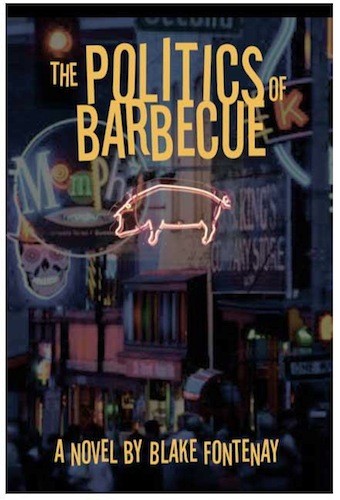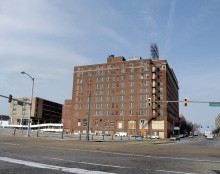In a community where head-on collisions in the public sphere are becoming commonplace, a new one is about to occur. We can designate it as Strickland vs. Wharton — a term that is both shorthand metaphor for a more complicated conflict and a literal foreshadowing of a likely political contest to come.
In a nutshell, Memphis mayor A C Wharton has proposed a 47-cent tax increase in order to pay for the last year of the city’s liability to Memphis City Schools and to provide what the mayor describes as a streamlined version of essential services. Second-term councilman and current budget chairman Jim Strickland not only resists the idea of a tax hike, he has publicly called for quite the opposite — a tax decrease that would reduce the current city property tax rate by roughly half as much as Wharton’s proposal would raise it.
Strickland, who represents a largely Midtown/Poplar Corridor constituency, has pinpointed the city’s problems as stemming from three specific areas — “schools, crime, and taxes.” And, while a budget plan of his own, vented last week, promises to do justice to the first two issues, Strickland lavishes most of his argument on what he sees as a growing tax burden on Memphians, one disproportionate, rate-wise, to the rest of Tennessee and one which he says is causing people “to vote with their tail-lights,” fleeing to nearby suburbs.
Contrasting his own proposal with that of Wharton, Strickland recommends budget cuts that become more serious the further away they are from the categories of public safety, school spending obligations, and “services directly affecting the public.”
He presents figures purporting to show that the mayor’s budget plan would result in a city tax rate of $3.68 per each hundred dollars of assessed value on a taxpayer’s real property and a combined city/county rate of $7.68. That would expand the current city rate of $3.198 and the current city/county rate of $7.21.
Strickland’s own figures for an “initial tax cut” in his plan (presumably tax cuts would continue in later stages) are $2.91 for a city tax rate and $6.193 for a combined city/county tax rate — a measurable decline.
Most council members at present find themselves somewhere in the middle between Wharton and Strickland on the tax issue, and somewhere in the middle is where the final budget will likely rest.
In the meantime, Strickland, acting in the role of budget chair that has seen him preside over several budget sessions so far, in which various unions and city departments have presented their wish lists, has called for maximum public participation in a culminating public budget session at City Hall on May 22nd.
Win or lose in the current showdown he has invited with Wharton, the councilman, who has long harbored mayoral ambitions, will have paved the way for another possible public reckoning down the line — say, in 2015.
• There’s no getting away from it: Money and the lack of it both figure large, not only in government but in political campaigns.
When 9th District congressional candidate Tomeka Hart opened up her headquarters in Chickasaw Crossing on Poplar last Thursday night, she made it a point to say she was running against “two millionaires, actual millionaires, one in the primary, one in the general election.”
The reference to “two millionaires” was Hart’s way of designating current 9th District incumbent Democrat Steve Cohen and George Flinn, the wealthy radiologist/radio magnate who is a candidate for the 9th District seat in the Republican primary.
There is no question that Flinn’s personal fortune can be measured in the several millions. In a losing 2010 race in the Republican primary for the 8th District congressional seat won by current incumbent Stephen Fincher of Crockett County, Flinn spent something like $5 million out of his own pocket. He also spent prodigiously in a race for Shelby County mayor in 2002, overpowering veteran Republican Larry Scroggs in the GOP primary but losing to Democrat Wharton in the general.
Flinn’s Republican opponent in the current Republican primary is the woefully underfunded Charlotte Bergmann, who was the GOP nominee against incumbent Cohen in 2010 and finished well behind him. Though she remains active and has done what underdogs normally do (and normally do in vain) — i.e., challenge the highly favored Flinn to debate — her chances of reaching the general (where she lost badly to Cohen in 2010) are remote.
Hart, too, will have trouble getting there. Admitting her relative lack of fund-raising success so far, Hart said, “Pundits want to see how much money you’ve got in the bank, and then they write you off. If it was about money, I wouldn’t be out there, because we knew in April I wouldn’t have money, right? If it was about money, I’d have been gone a long time ago. But it’s about work.”
Hart is reasonably well known, both for her leadership of the local Urban League chapter (from which she has taken a leave of absence) and as a member of the former Memphis City Schools board and current Unified Shelby County School Board. It was she, along with fellow board member Martavius Jones, who took the lead in the surrender of the MCS charter in late 2010 (a fact that could potentially cut both ways for her politically).
But she is no match, name-recognition-wise, for Cohen, the three-term incumbent and longtime former state senator who has been a major factor in both Memphis and Tennessee politics for more than three decades.
And there’s that “millionaire” thing. Technically, Cohen would seem to be a millionaire. According to the watchdog site OpenSecrets.org, Cohen’s net worth in 2010 (the last year for which such information is available) was between $1.3 and $3.8 million, making him the 111th wealthiest congressman out of 435. (Hat-tip to Marty Aussenberg for this nugget.)
But, from the standpoint of wealth, the congressman is by no means in Flinn’s league, and he is not known, as the Republican is, for self-funding. At the recent opening of a Democratic headquarters in Memphis, Cohen underscored the difference. “While our Republican opponent is going to spend lots of money,” he said, “we’re going to let him spend it.” Whereupon the congressman went on to chide Flinn for not using his resources instead to endow local medical institutions.
More ominous for Hart is the million dollars or so the congressman has raised for his political war chest.
At her headquarters opening, Hart promised to focus on local issues in a way that she contended Cohen has not. The incumbent, she said, is “not about local issues, but all about national politics. … That seat should be completely about what’s going on in Memphis.”
Hart said she had asked Cohen for aid and support of the school-merger movement but had been turned down. “The response was he wasn’t getting involved in local issues,” Hart said.
All of Cohen’s former opponents have tried to take some such tack, but so far to little or no avail. In fairness and in fact, the congressman keeps a very high profile on local matters, both personally and through the efforts of his staff. His office has continued the tradition of hands-on constituent service made famous by Cohen’s two immediate predecessors, Harold Ford Sr. and Harold Ford Jr.
And not a week goes by without Cohen figuring in some item of local consequence — whether in a ceremony honoring some local son or daughter (like the one last week for Lieutenant Colonel Luke Weathers, an African-American air ace from World War Two) or in announcing a $700,000 grant for LeMoyne-Owen College or $10 million for local health clinics.
“Forget what you might hear. We’re in this,” said Hart last week. But without a large local network (hers at present consists largely of fellow members of New Path, the local activist group that first boosted her into public life) and without real money to run on, she, like her GOP counterpart Bergmann, may have a hard time getting traction.
Given that neither is likely to engage her opponent in public debate, one wonders why these two African-American women, each bearing the burden (or the blessing) of underdog status, shouldn’t do something precedent-shattering and attention-getting like, say, debating each other. It’s as good as any other strategy they might have. And it’s free.



